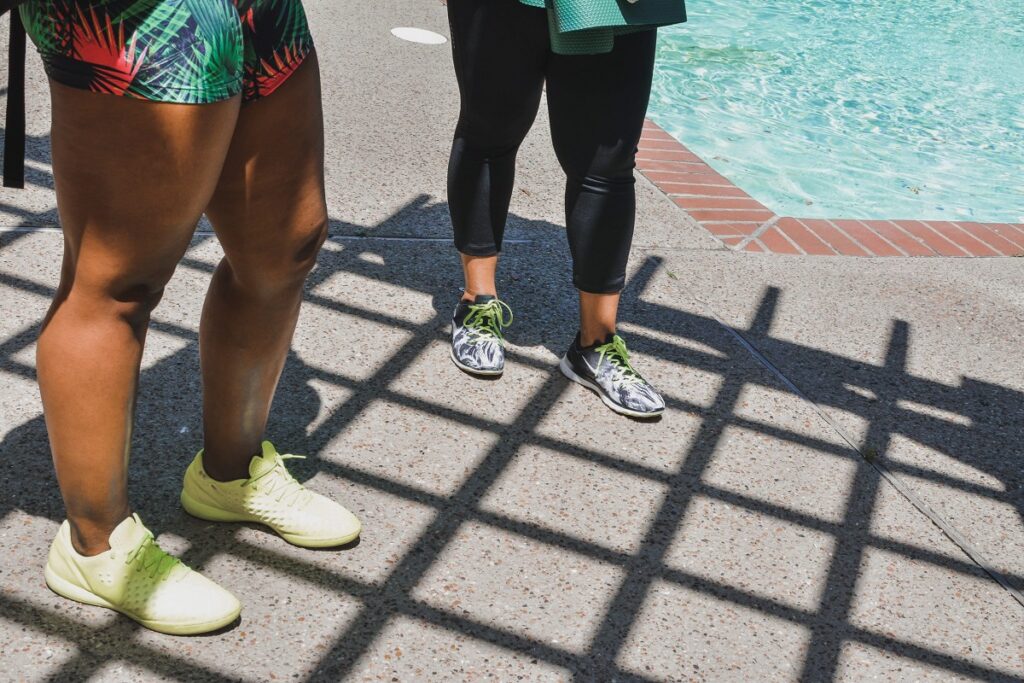
Researching Diastasis Repair & Treatment Options
How To Fix Diastasis Recti
So, I’ve been working on this post for a while now. After giving birth to my third baby in March of this year, I was diagnosed with diastasis recti earlier this Summer. My first question after being diagnosed was: how can I fix diastasis recti at home? Right now, with COVID-19 floating around (for lack of a better phrase) I’m, of course, trying to limit prolonged contact with anyone outside of our household. So, I researched like crazy and even talked to some Moms I knew who’ve dealt with this.

DISCLOSURE: I only recommend products I would use myself and all opinions expressed here are our own. This post contains affiliate links from which I earn a commission, at no extra cost to you, when you make a purchase. Read more about it HERE.
I discovered that there’s still a lot of conflicting info out there on what diastasis recti is and how to treat it. And even though this condition effects about 45% of moms at 6 months postpartum, we don’t talk about it nearly enough.
So, along with reading as much as I could and chatting with other moms, I interviewed the amazing Dr. Jackie White of Bodefinity in Atlanta, GA. Dr. Jackie is a pelvic physiotherapist who has helped tons of women through their diastasis recti diagnoses and, ya’ll, she dropped sooo much knowledge! Keep reading to grab a few nuggets for yourself; you can also watch the full interview below.
What Is Diastasis Recti?
So, diastasis recti refers to the separation of the rectus abdominis (or your six pack muscles). It can be very slight or a complete separation which can result in a bit of a pooch or a bulge in your tummy when you flex your ab muscles or cough. I started to notice a slight pain behind me bellybutton that would intensify after working out (I was doing a lot of ab work). That lead me to see my doc who made the official diagnosis. You can also check at home by doing a crunch or a sit up while placing your fingers in the center of your tummy. If, when you sit up, you feel a gap, then you may have diastasis recti.

Join the All Day Britney tribe for more Black Owned Features and all things style & family!
Chatting With Other Moms About Diastasis Recti
Once I received my diagnosis, one of the first things I did was reach out to other women who were also dealing with diastasis recti. One of the first mamas I spoke with, Tonesha Russell of www.ToneshaRussell.com & the Bread For Today podcast, noticed after the birth of her first baby, that she still had a pooch even though she had lost her baby weight. After her second, she did some research and discovered diastasis recti. Her OB directed her to try doing 100 crunches a day for a three months before she agreed to refer her to a physical therapist.
Tonesha’s third baby was born via c-section during which her doctor supposedly fixed her diastasis recti. But, when she still had back problems and bulging in her tummy, she took matters into her own hands and began a Pilates routine under the supervision of her friend and Pilates instructor who had also been diagnosed with diastasis recti. Today, she estimates her gap is about 4cm’s wide and so she’s considering meeting with a physical therapist soon.
Like me, another mom I spoke with, did a ton of research as soon as she was diagnosed. She worked with several regular physical therapists with no change in her condition before finally receiving a referral to one that specializes in pelvic floor care. She also recommended the MUTU home training system, but more on that later.
Another mama I chatted with hadn’t been formally diagnosed, but, discovered her diastasis recti through researching online and checking herself. She was still researching programs she thought might help, but was also considering surgery.
How Do You Repair Diastasis Recti?
I knew when I sat down with Dr. Jackie, that she would be able to provide insightful commentary on the diastasis recti, but I was BLOWN AWAY by all the info she shared during our chat (seriously; if you haven’t watched yet, go do that NOW). My biggest takeaway? Diastasis recti treatment is not as straightforward as many think. It’s so much more than just an “ab issue”, which explains why the 100 crunches that Tonesha’s OB suggested may not have been the best approach.
It involves your entire core which includes your rectus abdominis, oblique muscles, multifidus, pelvic floor and, of course, your transverse abdominis, which Dr. Jackie refers to as your corset muscles. All of these muscle groups work together to keep you stable and give you strength, and they can all be effected by diastasis recti. So, when seeking out a physical therapist to help, you want one that specializes in the pelvic floor and can prescribe a complete plan of action.

Choosing The Right Physical Therapist
So, how do you know which physical therapist is right for you? We’re military, so I had to go through Tricare for my referral. The folks they initially sent me to said they could help even though they didn’t even mention diastasis recti on the list of conditions they specialize in on their website. So, I held off on making an appointment with them. According to Dr. Jackie, when dealing with diastasis recti repair, your best bet is an actual pelvic physical therapist. All therapists have a certain level of knowledge involving most types of physical therapy, but a pelvic therapist is certified and has taken special classes dealing with the pelvic floor and the rest of your core. They know it inside and out, so they’re the best choice to help treat your diastasis recti.
If you’re looking for a pelvic physical therapist, here are the questions Dr. Jackie suggests we ask when choosing a physical therapist to work with:
- How many women with this diastasis recti have you treated? What’s your success rate? Were there any challenges along the way?
- What post-ed courses have you taken in pelvic care?
- What exercises can I do at home to continue my healing? Anything I should avoid?
Repairing Your Diastasis Recti At Home
Those last two are my own, but you get the picture! Once you’ve received guidance and the green light for at-home therapy from your doc, you may consider diastasis treatment at home. Honestly, I’ve have slowed way down in the exercise department. I take walks with the girls most days and do Zuma sometimes and that’s about it. But, Dr. Jackie says you don’t have to be afraid of exercise. The biggest thing is working with a physical therapist to come up with an exercise routine that’s both safe and effective for your particular situation.
There are some great options out there! Dr. Jackie, of course, offers her own Fix My Diastasis Recovery Program. Her program includes:
- A one-on-one consult to get you started,
- Weekly positive affirmations to promote healing and self-care,
- Evidence-based workout routines for safe recovery
- Breathing exercises and effective ways to manage pressure
- Tips on how to modify your every day behavior to stay safe and avoid exacerbating your diastasis recti
Alternatively, lucky Georgia residents can also request a telehealth physical therapy session with Dr. Jackie. (Perfect for several conditions, not just diastasis recti).

Alternative Treatment Programs
Another option is the MUTU System, a 12 week exercise program designed specifically for mamas with diastasis recti. You can get the workouts on your phone, smart tv, computer, or tablet and they’re super easy, quick, and also evidence-based. If you prefer to work with someone one on one, you can also use their search tab to find a certified MUTU expert in your area. There’s also a 100% money-back guarantee if you give the MUTU system a try and decide it’s not for you.
One mom I chatted with recommended Every Mother. Every Mother is a subscription-based system that’s broken down into three stages. The first stage, Prepare, is for mamas-to-be who want to avoid common pregnancy-related aches and pains. Reclaim, the second stage, is for mamas in their first six weeks of postpartum. The last stage, Surpass, can be built into your existing fitness regimen, but it also works as a standalone program. When you sign up, Every Mother asks you a few questions and will then recommend a specific stage based on your answers.
A Word On Diastasis Repair Surgery
Some moms end up going the surgery route to repair their diastasis recti. Dr. Jackie recommends trying physical therapy for at least a year before going with other options. This makes sense, considering the study Dr. Jackie told me about cited that only 32% of moms still have some level of diastasis recti at twelve months postpartum. There’s a good chance that the physical therapy will work or your diastasis recti will heal on its own within that timeframe.
It’s also important to note that surgery is not a sure thing. The recovery period can be strenuous, and it can be difficult to get insurance companies to pay, so some women end up footing the bill themselves. Here’s a great article that discusses the pros and cons of diastasis recti repair surgery. Here’s also an amazing support group on Facebook for you to check out, should you decide to go that route.
So, now you know everything there is to know about diastasis recti repair. Or at least, everything I know. Have any of you mamas dealt with (or are dealing with) this condition? I would love to hear from you in the comments! And please stay tuned! I’ll be sharing updates on my own diastasis recti treatment here very soon!






6 Comments
Anita B.
This was so informative and just the information I’ve been looking for. I’m currently dealing with diastasis recti and my body self confidence has taken a a major blow. I’ve thought about getting physical therapy but I’m glad to know that there are other options available that work. Thanks for sharing this info!!
Britney
My pleasure! Let me know which program you decide to try out. And good luck with your journey!
Patrice
Wow. This is really interesting information. There are so many things about pregnancy and women’s health that are overlooked or not paid any attention to. Great information for women who may be experiencing the same thing to know.
Britney
Thanks for checking it out! And yes, it’s disappointing how many of our issues are taken for granted. Just trying to help spread awareness
Cassandra
This was so informative! Really enjoyed reading it!
I didn’t know about it until now. Didn’t have any signs of it after my first pregnancy but i will definitely keep this article handy for my second pregnancy. It’s great that you provide us with concrete information and talk openly about it as a common diagnosis that some women have.
Britney
Thanks for reading! I first heard about it when I was pregnant with my first and completely forgot until I was recently diagnosed.